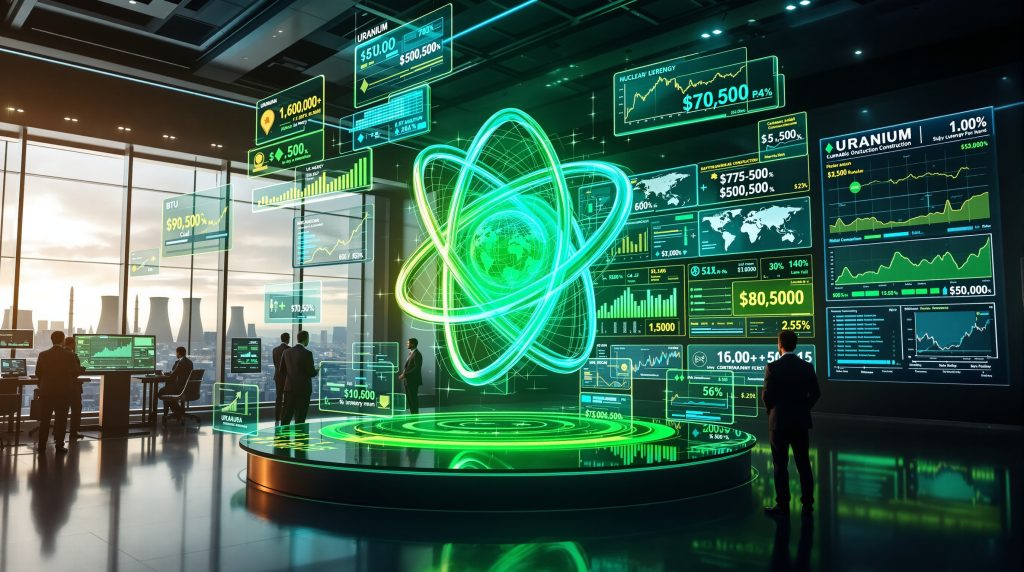The global energy landscape stands at a crossroads where traditional commodity pricing models fail to capture uranium's true value of the world's most concentrated energy source. While markets continue to price uranium as just another mining commodity, the fundamental physics of nuclear energy suggests a profound economic disruption may be inevitable. This disconnect between uranium's true value and its current market valuation represents one of the most significant pricing anomalies in modern commodity history.
The relationship between energy content and market price reveals striking inefficiencies across the global energy sector. Furthermore, understanding uranium supply‐demand dynamics becomes increasingly critical as nations grapple with energy security concerns and climate commitments.
Energy Density Economics and Fuel Comparison Analysis
The thermodynamic properties of different fuel sources create vast disparities in energy concentration that current markets fail to properly reflect. Coal, the traditional baseline for thermal energy comparison, contains approximately 10,500 BTU per pound according to U.S. Energy Information Administration specifications. This energy density has anchored fossil fuel pricing models for over a century.
Nuclear fuel presents a dramatically different energy profile. Natural uranium, when processed through commercial light-water reactors, delivers approximately 1.6 to 2.0 billion BTU per pound of usable energy. This represents a concentration factor of roughly 160,000 times greater than coal on a per-pound basis.
The theoretical maximum energy density of uranium-235, if fully fissioned, reaches approximately 37 billion BTU per pound. These figures highlight uranium's true value in ways that traditional commodity markets have yet to recognise.
Key Energy Density Comparisons:
• Coal (bituminous): 10,500 BTU/lb
• Natural gas: 21,000 BTU/lb
• Petroleum: 19,000 BTU/lb
• Uranium (reactor fuel): 1.6-2.0 billion BTU/lb
• Uranium-235 (theoretical): 37 billion BTU/lb
The mathematical relationship reveals that one pound of reactor-grade uranium contains the energy equivalent of approximately 1,500 tons of coal. At current commodity prices, with coal trading between $50-100 per ton and uranium at approximately $85-95 per pound, the energy-adjusted pricing suggests uranium trades at roughly 2-3% of its thermodynamic parity value.
Modern nuclear reactors achieve thermal-to-electric conversion efficiency of approximately 32-33%, comparable to coal-fired power plants. However, nuclear facilities maintain capacity factors averaging 92.5% globally, significantly higher than coal plants at 40-50%.
Reactor Efficiency Metrics:
• Thermal efficiency: 32-33% (nuclear) vs 35-40% (modern coal)
• Capacity factor: 92.5% (nuclear) vs 40-50% (coal)
• Annual fuel requirement: 150-200 tonnes natural uranium per 1,000 MW reactor
• Fuel cost component: 10-15% of levelised cost (nuclear) vs 25-35% (coal)
Market Pricing Mechanisms and Valuation Gaps
The disparity between uranium's energy content and market price reflects complex factors beyond simple supply and demand dynamics. Current uranium spot price trends incorporate substantial non-energy components including mining costs, conversion expenses, enrichment services, fuel fabrication, transportation security, and regulatory compliance.
These embedded costs create a "regulatory premium" that obscures the underlying energy value. Consequently, investors must understand how these factors impact uranium's true value assessment.
Uranium Cost Structure Breakdown:
| Cost Component | Range ($/lb U3O8) | Percentage of Total |
|---|---|---|
| Mining & Milling | $15-25 | 20-30% |
| Conversion | $5-10 | 6-12% |
| Enrichment | $50-100 | 60-65% |
| Fuel Fabrication | $8-15 | 10-18% |
| Transport & Security | $3-8 | 4-9% |
The enrichment process, measured in Separative Work Units (SWU), represents the largest cost component in delivered nuclear fuel. Current enrichment capacity constraints and technology limitations create artificial supply bottlenecks unrelated to uranium ore availability.
Each SWU requires approximately 5-8 kWh of electricity, adding substantial embedded energy costs to the final fuel product.
Physics-based valuation models suggest dramatically different pricing scenarios. If uranium were priced purely on energy content parity with coal at $60-80 per ton, the theoretical value would reach $4,800-6,400 per pound. Even accounting for reactor efficiency losses and fuel cycle costs, energy-equivalent pricing would support uranium values in the $1,200-3,000 per pound range.
Market structure factors further constrain price discovery. Approximately 70-80% of uranium supply operates under long-term contracts, limiting spot market liquidity. The concentrated end-user base, primarily utilities and government programs, reduces competitive pricing pressures typically seen in other commodity markets.
Nuclear Renaissance and Global Construction Pipeline
Global nuclear capacity expansion is accelerating across multiple regions, driven by energy security concerns and decarbonisation commitments. As of November 2025, 440 nuclear reactors operate worldwide, generating approximately 390-410 GW of electricity.
Construction activity has intensified, with 12-15 new reactor starts annually since 2020. This expansion directly impacts uranium's true value by increasing long-term demand projections.
Regional Nuclear Development Status:
China leads global expansion:
• Operational reactors: 54 units
• Under construction: 19-21 reactors
• Planned additions: 30+ reactors through 2035
• Target capacity: 500+ GW by 2030
United States maintains largest fleet:
• Operational: 93 reactors (largest globally)
• Under construction: 2 units (Vogtle 3&4)
• SMR development: Multiple advanced designs approved
• Capacity extensions: 20+ reactors licensed for 80-year operation
India accelerates domestic program:
• Operational: 24 reactors
• Under construction: 8 units
• Planned: 10+ additional reactors by 2030
• Indigenous technology focus: Heavy-water reactor designs
Small Modular Reactor (SMR) technology represents a paradigm shift in nuclear deployment. NuScale Power received final design approval from the U.S. Nuclear Regulatory Commission, with first commercial deployment planned for 2029.
SMR designs offer enhanced safety features, reduced capital requirements, and flexible siting options that could dramatically expand nuclear energy applications. This expansion potential is crucial for understanding uranium's future market position.
Supply-Demand Structural Imbalances
Current uranium production capacity shows significant structural deficits relative to projected demand growth. Global mine production in 2024 totalled approximately 57,000 tonnes of uranium, while reactor fuel requirements approached 65,000 tonnes annually.
This production shortfall, covered by secondary supply sources and inventory drawdowns, creates increasingly tight market conditions. Moreover, geopolitical uranium risks add complexity to supply chain planning.
Primary Production Analysis:
• Kazakhstan: 43% of global production (24,500 tonnes)
• Canada: 15% of global production (8,500 tonnes)
• Australia: 12% of global production (6,800 tonnes)
• Top 3 countries: 70% of total mine supply
This geographic concentration creates supply chain vulnerabilities, particularly given Kazakhstan's exposure to geopolitical disruptions. Canadian production from the Athabasca Basin provides the highest-grade uranium globally, with ore grades averaging 10-20% U3O8 compared to the global average of 0.1-0.5%.
Secondary supply sources, including highly enriched uranium downblending, weapons stockpile conversion, and recycled reactor fuel, have historically provided 15-20% of reactor requirements. These sources face depletion timelines, with weapons-grade uranium conversion programs largely completed and recycling infrastructure limited.
Demand Growth Projections:
| Timeframe | Annual Demand | Supply Gap | Price Impact |
|---|---|---|---|
| 2025-2027 | 70,000-75,000 tonnes | 10,000-15,000 tonnes | Moderate pressure |
| 2028-2030 | 80,000-90,000 tonnes | 20,000-25,000 tonnes | Significant pressure |
| 2031-2035 | 100,000+ tonnes | 35,000+ tonnes | Critical shortage |
Utility stockpiles, traditionally maintained at 2-3 years forward coverage, have declined to approximately 1.5-2 years in many regions. This inventory reduction reflects both cost management during the low-price environment (2011-2020) and increased confidence in supply chain reliability.
However, tightening markets may force inventory rebuilding, amplifying demand pressures. The lead time for new uranium mine development typically spans 7-10 years from discovery to production.
Current exploration spending remains below levels necessary to replace depleting reserves, creating a development pipeline insufficient to meet projected demand growth. This exploration deficit suggests supply constraints may persist well into the 2030s.
Industrial and Manufacturing Transformation Scenarios
Higher uranium pricing scenarios would fundamentally alter global industrial competitiveness patterns. Nations with substantial nuclear capacity could achieve significant energy cost advantages as fossil fuel prices face carbon taxation and volatility pressures.
This energy arbitrage opportunity could drive industrial relocations and reshape manufacturing economics. US ISR uranium production development represents one approach to securing domestic supply chains.
Energy Cost Sensitivity Analysis:
Energy-intensive industries show varying sensitivity to uranium price increases:
• Aluminium smelting: 25-35% of production costs from electricity
• Steel production: 15-20% of costs from energy inputs
• Chemical manufacturing: 10-25% depending on process type
• Data centres: 15-25% of operating costs from electricity
Even substantial uranium price increases to $200-300 per pound would raise nuclear electricity costs by only 1-2 cents per kWh, maintaining significant advantages over fossil fuel alternatives facing carbon pricing.
This cost structure suggests nuclear-powered regions could capture growing shares of energy-intensive manufacturing.
Regional Competitive Advantages:
France: 70% nuclear electricity generation provides stable, low-carbon industrial power
South Korea: 30% nuclear share supports advanced manufacturing competitiveness
Ontario, Canada: Nuclear dominance enables competitive aluminium and steel production
UAE: New nuclear capacity enhances industrial diversification beyond oil dependence
The emergence of industrial heat applications for nuclear reactors could create entirely new uranium demand categories. High-temperature reactors capable of providing 750-950°C process heat can substitute for fossil fuels in steel, cement, and chemical production.
This industrial decarbonisation pathway could add 15-25% to total uranium demand by 2040. Hydrogen production through nuclear electrolysis represents another transformative application.
Nuclear-powered hydrogen could achieve production costs of $2-4 per kilogram, competitive with fossil fuel-based methods while eliminating carbon emissions. Large-scale hydrogen production for industrial feedstock and transportation fuel could substantially expand nuclear deployment beyond electricity generation.
Grade-Price Viability and Resource Activation
Current uranium mining operations focus primarily on deposits with grades exceeding 0.1% U3O8, representing the economic cutoff under recent pricing conditions. Higher uranium prices would dramatically expand the resource base by enabling extraction from lower-grade deposits previously considered uneconomic.
This relationship is fundamental to understanding uranium's true value potential over time.
Grade Distribution Analysis:
| Grade Range | Resource Estimate | Current Status | Activation Price |
|---|---|---|---|
| >1.0% U3O8 | 500,000 tonnes | Active mining | <$50/lb |
| 0.1-1.0% U3O8 | 2,000,000 tonnes | Mostly active | $40-80/lb |
| 0.05-0.1% U3O8 | 3,500,000 tonnes | Marginal/inactive | $80-150/lb |
| 0.02-0.05% U3O8 | 8,000,000+ tonnes | Uneconomic | $150-300/lb |
At uranium prices of $200-300 per pound, numerous currently marginal deposits would become highly profitable. Colorado Plateau sandstone deposits, Australian calcrete resources, and Mongolian roll-front systems could support substantial production increases.
This grade-price relationship suggests uranium supply is highly elastic above current pricing levels.
Technology-Enabled Resource Access
In-situ recovery (ISR) methods show particular promise for lower-grade deposits. ISR operations can achieve extraction costs of $25-45 per pound for suitable geology, well below other mining methods. Approximately 30-40% of global uranium resources are amenable to ISR extraction, providing significant expansion potential.
Advanced extraction technologies under development include:
• Bioleaching systems for low-grade ores
• Seawater uranium extraction (Japan leading development)
• Heap leaching for disseminated deposits
• Enhanced recovery from existing tailings
Seawater uranium extraction, while currently experimental, could provide virtually unlimited resources at production costs estimated at $300-500 per pound. Japanese research programs have demonstrated technical feasibility, with commercial deployment dependent on higher uranium prices justifying the energy-intensive extraction process.
The reprocessing of existing uranium tailings and waste materials presents immediate resource expansion opportunities. Millions of tonnes of tailings from historical uranium mining contain recoverable uranium at grades of 0.02-0.05% U3O8.
At higher uranium prices, these materials could provide substantial secondary supply. For comprehensive analysis of current market conditions, review the World Nuclear Association's supply overview.
Investment Framework and Portfolio Implications
Understanding effective uranium investment strategies becomes crucial as uranium's true value recognition approaches. Physical uranium investment vehicles, including the Sprott Physical Uranium Trust and Yellow Cake PLC, provide direct commodity exposure without mining operation risks.
These investment structures have accumulated substantial uranium inventories, effectively removing supply from commercial markets.
Investment Exposure Mechanisms:
Physical Uranium Holdings:
• Sprott Physical Uranium Trust (SRUUF): 60+ million pounds held
• Yellow Cake PLC (YCA): 17+ million pounds held
• Uranium Participation Corporation: 16+ million pounds held
• Combined holdings: ~100 million pounds (15-20% of annual demand)
Uranium mining companies trade at historically low valuations relative to resources and production capacity. Enterprise values often reflect uranium prices of $40-60 per pound, well below current spot pricing. This valuation disconnect suggests substantial upside potential for mining equities under higher uranium price scenarios.
Leading Producer Valuations (2025):
| Company | Resource Base | Current Valuation | Break-even Price | Upside Potential |
|---|---|---|---|---|
| Cameco Corp | 500M+ lbs | $15B market cap | $35-45/lb | High leverage |
| Kazatomprom | 800M+ lbs | $8B market cap | $25-35/lb | Geopolitical risk |
| Paladin Energy | 150M+ lbs | $2B market cap | $45-55/lb | Development upside |
Nuclear utilities face fuel cost exposure that varies significantly with uranium pricing. Companies with substantial nuclear generation capacity show different sensitivities to uranium price movements. Portfolio diversification benefits emerge from uranium's low correlation with traditional financial assets.
Historical analysis shows uranium price movements correlate weakly with equity markets, bonds, and most commodities, providing hedge characteristics during market volatility periods. For current market data, consult Trading Economics uranium pricing.
Risk-Adjusted Return Projections:
Conservative uranium price scenarios ($120-150/lb by 2027) suggest potential returns of 15-25% annually for mining equities and 8-12% for physical uranium holdings. More aggressive scenarios ($200-300/lb) could generate returns exceeding 25-40% for well-positioned mining companies.
Institutional investors are increasingly recognising uranium's strategic value. Sovereign wealth funds from uranium-consuming nations are building positions to secure long-term supply. Pension funds with long investment horizons find uranium's structural supply-demand imbalance attractive for portfolio diversification.
Future Market Dynamics and Price Discovery
The uranium market stands at an inflection point where multiple factors converge to support higher pricing. Energy security concerns, accelerating nuclear deployment, supply chain constraints, and climate policy mandates create a confluence of demand drivers.
Meanwhile, years of underinvestment in exploration and mine development limit supply response capabilities. The recognition of uranium's true value becomes increasingly inevitable under these circumstances.
Catalyst Identification for Price Discovery:
Near-term catalysts (2025-2027):
• Utility long-term contract negotiations at higher prices
• Strategic reserve building by importing nations
• SMR deployment announcements and fuel contracting
• Mine supply disruptions or production delays
Medium-term catalysts (2027-2030):
• Commercial SMR operations driving demand growth
• Industrial nuclear applications gaining adoption
• Secondary supply source depletion
• Carbon pricing making nuclear more competitive
Long-term catalysts (2030-2035):
• Large-scale nuclear hydrogen production
• Advanced reactor deployment accelerating
• Uranium supply shortages forcing industrial rationing
• Energy security policies mandating domestic nuclear fuel cycles
The timeline for uranium's true value discovery depends partly on market structure evolution. Increased spot market participation, financial investor involvement, and transparent price discovery mechanisms could accelerate the repricing process.
Conversely, continued reliance on long-term contracting and limited market liquidity may delay full price realisation.
Scenario Planning for Value Realisation:
Conservative scenario: Gradual price appreciation to $150-200/lb over 5-7 years as supply-demand balances tighten incrementally.
Moderate scenario: Acceleration to $250-400/lb within 3-5 years driven by supply disruptions and demand growth exceeding expectations.
Aggressive scenario: Rapid repricing to $500+/lb within 2-4 years due to strategic stockpiling, mine supply crises, or geopolitical uranium supply restrictions.
Market efficiency improvements through increased financialisation could help uranium pricing better reflect its fundamental energy value. However, regulatory constraints, security requirements, and the specialised nature of nuclear fuel markets may continue to limit pure market-based price discovery mechanisms.
The structural undervaluation of uranium relative to its energy content represents a profound market inefficiency that cannot persist indefinitely. As global nuclear deployment accelerates and supply constraints intensify, uranium's price discovery process will eventually align market valuations with thermodynamic realities, potentially reshaping energy economics and industrial competitiveness on a global scale.
The convergence of energy security imperatives, climate commitments, and supply chain vulnerabilities creates an unprecedented opportunity for uranium's true value recognition. Investors, policymakers, and industrial planners who understand these dynamics early may benefit substantially from uranium's inevitable journey toward its physics-based valuation. The question is not whether uranium will reach its true value, but rather how quickly markets will adapt to this fundamental energy reality.
Ready to Capitalise on Uranium's Energy Value Disconnect?
Discovery Alert's proprietary Discovery IQ model delivers real-time alerts on significant uranium and mining discoveries across the ASX, instantly empowering subscribers to identify actionable opportunities ahead of the broader market. Explore how historic mineral discoveries have generated substantial market returns by visiting Discovery Alert's dedicated discoveries page, then begin your 30-day free trial to position yourself ahead of uranium's inevitable value realisation.




